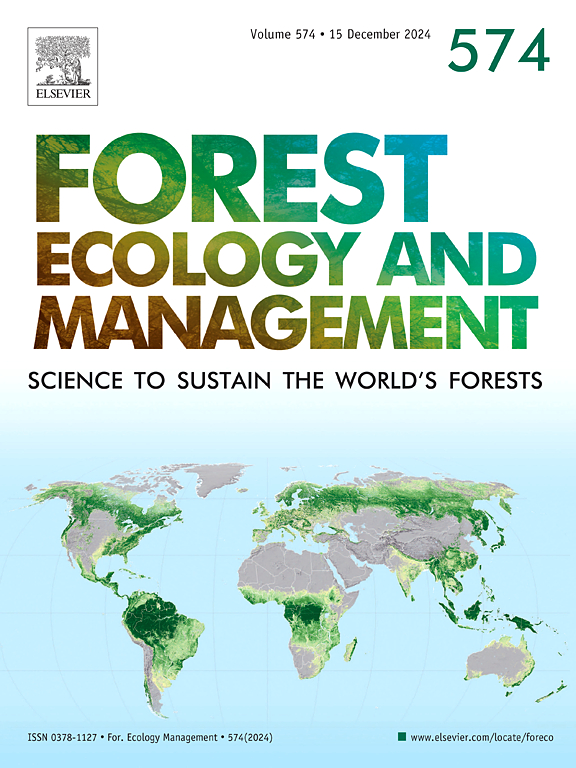麻萨诸塞州河岸森林中绿灰螟入侵对白蜡存活和生长的响应:生物防治的影响
IF 3.7
2区 农林科学
Q1 FORESTRY
引用次数: 0
摘要
绿灰螟虫(Agrilus planipennis, EAB)是一种入侵害虫,目前威胁着北美的原生灰资源,特别是绿灰(F. pennsylvania),这是一种在河岸生态系统和洪泛区森林中常见的物种。白蜡树的消失对这些栖息地提供的生态系统服务具有广泛的影响。通过从东亚EAB原生地引进膜翅类寄生蜂进行生物防治是一种潜在的长期管理解决方案;然而,目前尚不清楚该计划是否能保护成熟的白蜡树,因为白蜡树往往会屈服于EAB的初始入侵浪潮。本文评估了马萨诸塞州6个漫滩森林的白蜡树生长和死亡率对EAB入侵的响应,以及早期释放生物防治剂的影响。2017 - 2022年,在3个地点分别放生了拟寄生蜂农业乌比乌斯、鸡爪Spathius galinae和平腹棘螨Tetrastichus planipennisi。从2018年到2024年,我们测量了胸高直径,并评估了每个站点和三个非释放站点的大约100棵标记白蜡树的冠层状况。立地和初冠枯梢对白蜡树生长有显著影响。我们还发现,2024年在6个研究地点部署的哨点灰烬螺栓中,灰烬死亡率百分比与EAB幼虫的寄生水平呈负相关。这是文献中首次发现EAB幼虫寄生与灰烬健康结果之间的关系。未来的工作可能会研究这些结果是否适用于不同的栖息地和环境。本文章由计算机程序翻译,如有差异,请以英文原文为准。
Ash survival and growth in response to emerald ash borer invasion in Massachusetts riparian forests: Impacts of biological control
The emerald ash borer (Agrilus planipennis, EAB) is an invasive buprestid that currently threatens North America’s native ash (Fraxinus spp.) resource, particularly green ash (F. pennsylvanica), a species that is common in riparian ecosystems and floodplain forests. Loss of ash has widespread implications for the ecosystem services these habitats provide. Biological control, through the introduction of hymenopteran parasitoids from EAB’s native range in Northeast Asia, is a potential long-term management solution; however, it is unknown if the program can protect mature ash trees that often succumb to the initial wave of EAB invasion. We here assess the ash growth and mortality responses to EAB invasion at six floodplain forests in Massachusetts and the impacts of early releases of biological control agents. We released the parasitoids Oobius agrili, Spathius galinae, and Tetrastichus planipennisi at three sites from 2017 to 2022. From 2018–2024, we measured the diameter at breast height and assessed the canopy condition of approximately 100 tagged ash trees at each site plus three non-release sites. We found significant effects of site and initial crown dieback on ash tree growth. We also found that the percent ash mortality was negatively correlated to the level of parasitism of EAB larvae in sentinel ash bolts deployed across the six study sites in 2024. This is the first finding of a relationship between EAB larval parasitism and ash health outcomes in the literature. Future work could examine if these results extend to different habitats and environments.
求助全文
通过发布文献求助,成功后即可免费获取论文全文。
去求助
来源期刊

Forest Ecology and Management
农林科学-林学
CiteScore
7.50
自引率
10.80%
发文量
665
审稿时长
39 days
期刊介绍:
Forest Ecology and Management publishes scientific articles linking forest ecology with forest management, focusing on the application of biological, ecological and social knowledge to the management and conservation of plantations and natural forests. The scope of the journal includes all forest ecosystems of the world.
A peer-review process ensures the quality and international interest of the manuscripts accepted for publication. The journal encourages communication between scientists in disparate fields who share a common interest in ecology and forest management, bridging the gap between research workers and forest managers.
We encourage submission of papers that will have the strongest interest and value to the Journal''s international readership. Some key features of papers with strong interest include:
1. Clear connections between the ecology and management of forests;
2. Novel ideas or approaches to important challenges in forest ecology and management;
3. Studies that address a population of interest beyond the scale of single research sites, Three key points in the design of forest experiments, Forest Ecology and Management 255 (2008) 2022-2023);
4. Review Articles on timely, important topics. Authors are welcome to contact one of the editors to discuss the suitability of a potential review manuscript.
The Journal encourages proposals for special issues examining important areas of forest ecology and management. Potential guest editors should contact any of the Editors to begin discussions about topics, potential papers, and other details.
 求助内容:
求助内容: 应助结果提醒方式:
应助结果提醒方式:


